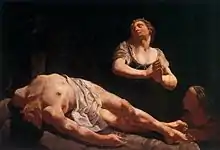Giulia Lama
Giulia Lama (1 October 1681 – 7 October 1747)[1] was an Italian painter, active in Venice. Her dark, tense style contrasted with the dominant pastel colors of the late Baroque era.[2]
Giulia Lama | |
|---|---|
_-_Museo_Nacional_Thyssen-Bornemisza_Madrid.jpg.webp) Portrait of Giulia Lama by Giovanni Battista Piazzetta | |
| Born | October 1, 1681 Venice, Italy |
| Died | October 7, 1747 (aged 66) Venice, Italy |
| Nationality | Italian |
| Known for | Painting |
| Wikimedia Commons has media related to Giulia Lama. |
Biography
Lama was born in the parish of Santa Maria Formosa in Venice. She was trained initially by her father, the painter Agostino Lama. She may have studied alongside a childhood friend, Giambattista Piazzetta (1682–1754), at the Scuola di Antonio Molinari in Venice. As a result of learning together their styles are similar in the sharp contrasts of light and shade. Piazzetta painted a portrait of his friend in c.1715–1720.
A letter written by the Abate Conti to Madame de Caylus in March 1728 has been important in determining Lama's background and character. He remarks, "The poor girl is persecuted by the painters, but her virtue triumphs over her enemies. It is true that she is as ugly as she is witty but she speaks with grace and precision, so that one easily forgives her her face."[3] The letter reveals that in addition to being a painter she was skilled in mathematics, poetry, and lace making.[3]

Lama was active as a historical painter and poet in Venice from till after 1753. One of her pieces, a Crucifixion altarpiece, remains in situ at San Vitale. She had a successful career in private and public figure painting. Lama appears to have been one of the first women to break the barrier against women studying and drawing the nude figure from life.[4] Over 200 drawings that were recently discovered clearly show that she indeed studied both male and female nude figures during her training. She had public success in a style that was typically a position held by men, giving rise to opposition from her male counterparts who were not prepared to tolerate such competition.
As a highly trained professional, she was just as capable of painting a sensitive portrait such as Young Man with a Turban as she was of carrying out large, original commissions, such as altarpieces, with confidence. It is through the identification of three such altarpieces in a Venetian guidebook of 1733 that Lama's artistic personality began to be reconstructed. That she was as fully competent as the male artists with whom she competed is demonstrated by the names to which her work has been attributed. Recovery of Lama's oeuvre has required reattribution of works by not only Piazzetta, but also artists such as Federico Bencovich, Domenico Maggiotto, Francesco Capella, and Zurbarán, among others.
Notes
- Buchholz, E. L. (2003). Women Artists. Germany: Prestel. p. 40. ISBN 3791329677
- Weidemann, Christiane, Petra Larass, and Melanie Klier. 50 Women Artists You Should Know. Munich: Prestel, 2008. ISBN 9783791339566. Page 45.
- Gaze, D. (1997) Dictionary of Women Artists: 2. London: Fitzroy Dearborn. p. 820. ISBN 1884964214
- "Lama, Giulia". Grove Art Online. 2003
References
- Bryan, Michael (1889). Walter Armstrong and Robert Edmund Graves (ed.). Dictionary of Painters and Engravers, Biographical and Critical (Volume II L-Z). York St. #4, Covent Garden, London; Original from Fogg Library, Digitized May 18, 2007: George Bell and Sons. p. 7.CS1 maint: location (link)